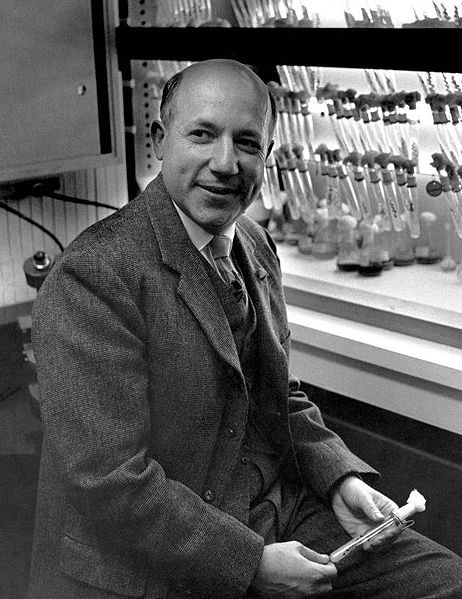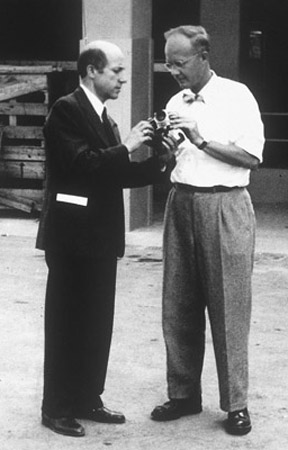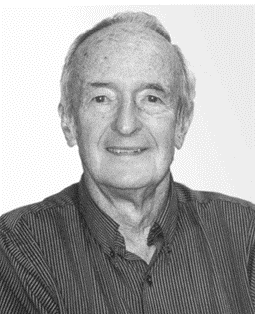<Back to Index>
- Chemist Melvin Ellis Calvin, 1911
- Biologist Andrew Alm Benson, 1917
- Chemist James Alan Bassham, 1922
PAGE SPONSOR

Melvin Ellis Calvin (April 8, 1911 – January 8, 1997) was an American chemist most famed for discovering the Calvin cycle along with Andrew Benson and James Bassham, for which he was awarded the 1961 Nobel Prize in Chemistry. He spent most of his five decade career at the University of California, Berkeley.
Calvin was born in St. Paul, Minnesota, the son of Russian Jewish immigrants. His father was born in Tsarist Lithuania and his mother in Tsarist Georgia. As a small child, Calvin's family moved to Detroit; he graduated from Central High School in 1928. Melvin Calvin earned his Bachelor of Science from the Michigan College of Mining and Technology (now known as Michigan Technological University) in 1931 and his Ph.D. in chemistry from the University of Minnesota in 1935. He then spent the next four years doing postdoctoral work at the University of Manchester. He married Genevieve Jemtegaard in 1942, and they had three children, two daughters and a son.
Calvin joined the faculty at the University of California, Berkeley, in 1937 and was promoted to Professor of Chemistry in 1947. Using the carbon - 14 isotope as a tracer, Calvin, Andrew Benson and James Bassham mapped the complete route that carbon travels through a plant during photosynthesis, starting from its absorption as atmospheric carbon dioxide to its conversion into carbohydrates and other organic compounds. In doing so, Calvin, Benson and Bassham showed that sunlight acts on the chlorophyll in a plant to fuel the manufacturing of organic compounds, rather than on carbon dioxide as
was previously believed. Calvin was the sole recipient of the 1961
Nobel Prize for Chemistry for what is sometimes known as the Calvin - Benson - Bassham Cycle. Calvin wrote an autobiography three decades later titled Following the Trail of Light: A Scientific Odyssey.
In it, he makes no mention of Andrew Benson and the fundamental,
formative contributions that Benson made to these discoveries.
During the 1950s he was among the first members of the Society for General Systems Research. In 1963 he was given the additional title of Professor of Molecular Biology. He was founder and Director of the Laboratory of Chemical Biodynamics and simultaneously Associate Director of Berkeley Radiation Laboratory, where he conducted much of his research until his retirement in 1980. In his final years of active research, he studied the use of oil producing plants as renewable sources of energy. He also spent many years testing the chemical evolution of life and wrote a book on the subject that was published in 1969.
On June 16, 2011, it was announced by the United States Postal Service that Melvin Calvin would be featured on the Forever Stamp, along with Severo Ochoa, Maria Goeppert Mayer, and Asa Gray. This was also announced on the Lawrence Berkeley National Laboratory home page.


Andrew Alm Benson (September 24, 1917 - January 16, 2015) was an American biologist and a professor of biology at the University of California, San Diego, until his retirement in 1989. He is known for his work in understanding the carbon cycle in plants.
Benson was born on September 24, 1917, in Modesto, California, the son of a rural physician of Swedish immigrant stock. He studied as an undergraduate and masters student at the University of California, Berkeley, where he learned optics from Luis Alvarez and worked in the chemistry lab of Glenn T. Seaborg. In 1942, he received his Ph.D. from the California Institute of Technology; at Caltech, he worked under the supervision of Carl Niemann, conducting experiments on the fluorination of thyroxine; his later thesis work concerned “periodate and lead tetraacetate degradation of its vicinal amino glycol”. At that time he also became a conscientious objector to the war in Europe, a political position that caused difficulties for him when he moved back to Berkeley following his graduation.
Benson returned to Berkeley as an instructor in July 1942. In May 1946 he was invited to join the group of Melvin Calvin, who was then starting a photosynthesis group in Berkeley's Old Radiation Laboratory, a building that had previously housed a 37 inch cyclotron built in 1937 by Ernest Lawrence. He visited Norway from 1951 to 1952 on a Fulbright fellowship to the Norwegian College of Agriculture, and took a faculty position at Pennsylvania State University in 1954. He moved to UCSD from a previous position at the University of California, Los Angeles, in 1962.
In work done from 1946 through 1953, along with Melvin Calvin and James Bassham, Benson elucidated the path of carbon assimilation (the photosynthetic carbon reduction cycle) in plants. The carbon reduction cycle is known as the Calvin cycle, which inappropriately ignores the contribution of Bassham and Benson. Many scientists refer to the cycle as the Calvin – Benson Cycle, Benson - Calvin, and some even call it the Calvin – Benson – Bassham (or CBB) Cycle.
In a 2002 paper, Benson provides an in-depth retrospective on his life and works.
Benson was elected to the National Academy of Sciences in 1972, the American Academy of Arts and Sciences in 1981, and the Norwegian Society of Arts and Letters in 1984. In 1962, the United States Department of Energy gave him the Ernest Orlando Lawrence Award for his work using radioactive isotopes to understand the carbon cycle. He also received the Sugar Research Foundation Award in 1950 and the Stephen Hales Prize of the American Society of Plant Biologists in 1972 for his discovery of ribulose as a product of the carbon cycle. In 2007, a special issue of Photosynthesis Research was dedicated to him in honor of his 90th birthday.

James Alan Bassham (November 26, 1922 in Sacramento, California - November 19, 2012) was an American scientist known for his work on photosynthesis.
He received a B.S. degree in chemistry in 1945 from the University of California and his Ph.D. degree in 1949. His graduate studies were on the subject of carbon reduction during photosynthesis, working with Melvin Calvin in the Bio - Organic Chemistry Group of the Lawrence Radiation Laboratory at the University of California. He continued his work as Associate Director of this group.
Besides his work on the basic carbon reduction cycle of photosynthesis, James Bassham conducted research on the biosynthetic paths leading from the cycle to the thermodynamics and kinetics of the carbon paths and the factors that control the flow of material and energy in this metabolic network. He is coauthor (with Melvin Calvin) of "The Path of Carbon in Photosynthesis".